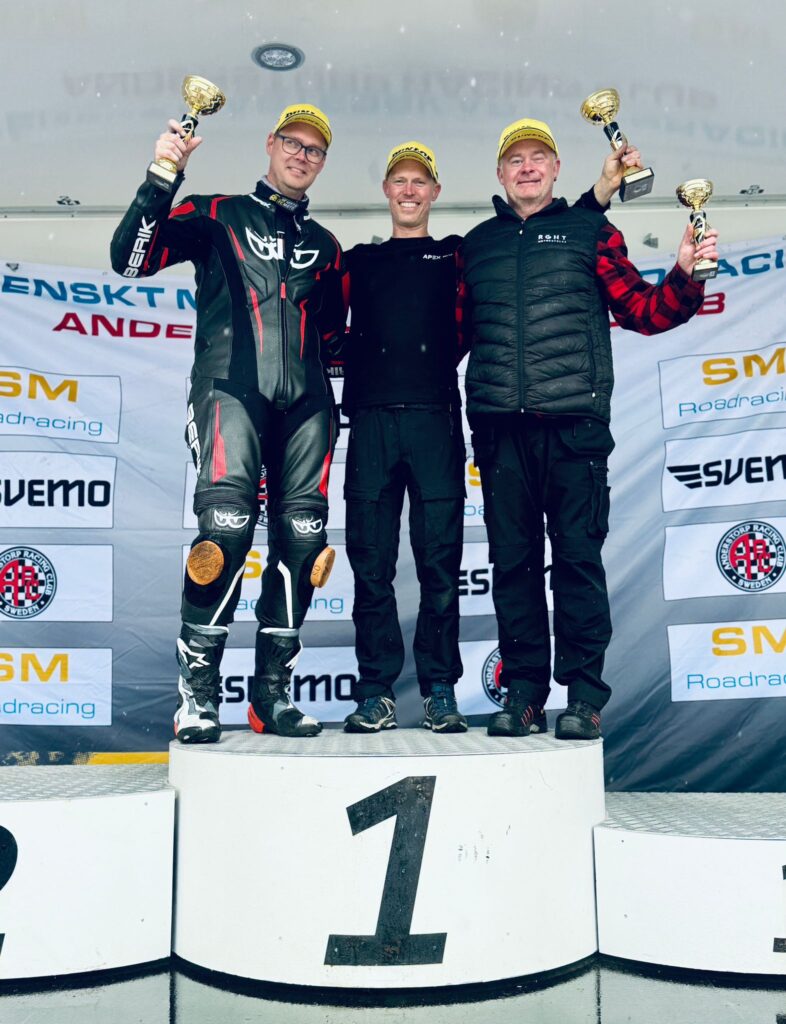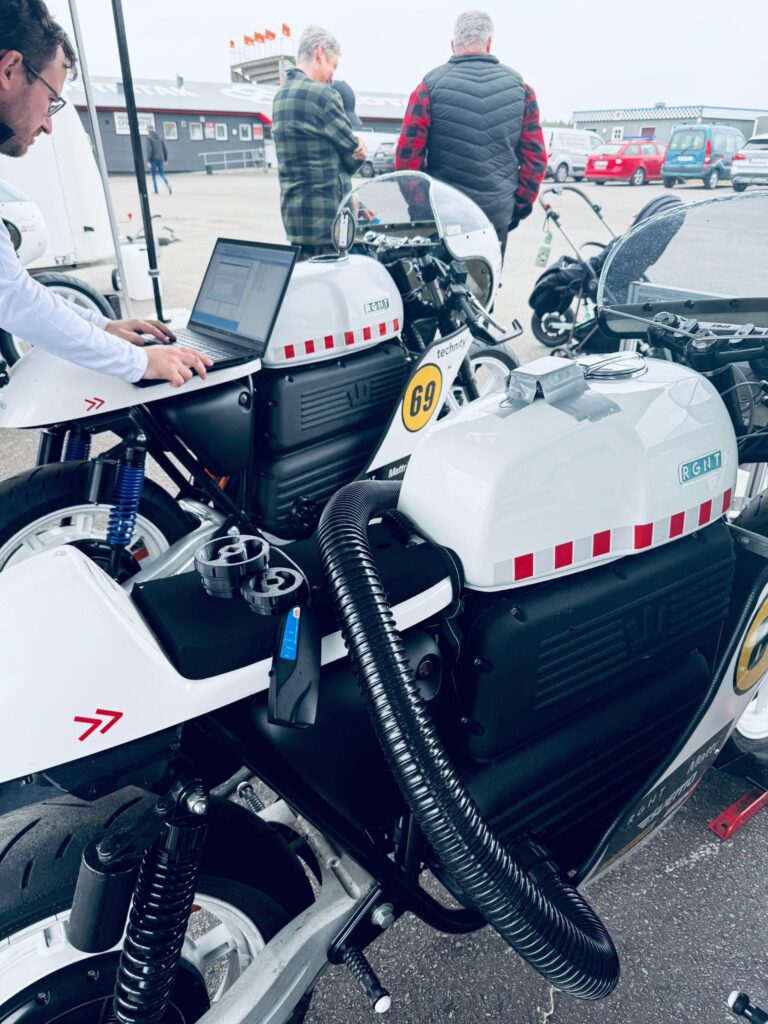RGNT RACING
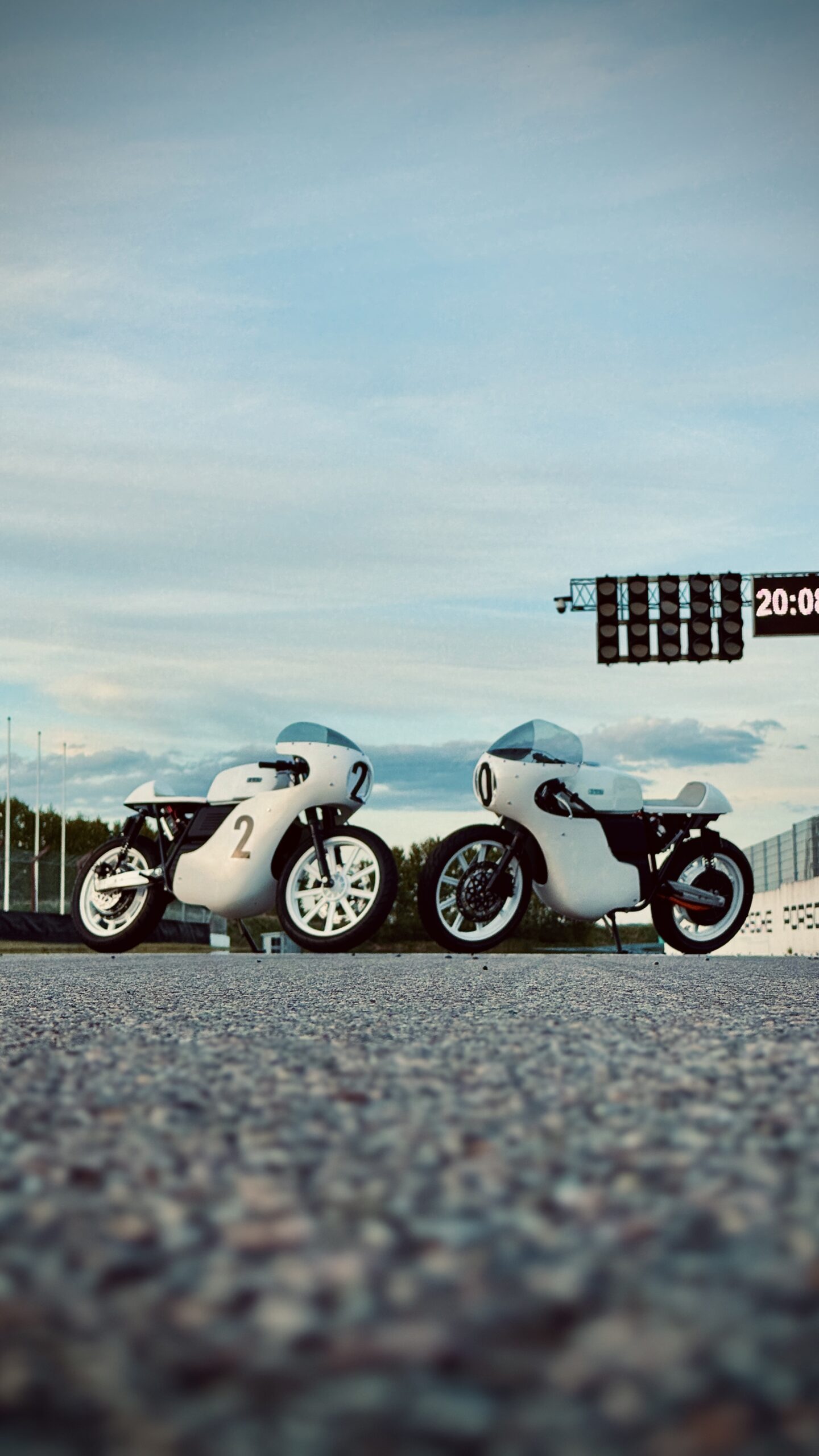
As early as 2022, Mattr Collective AB (one of several companies associated with RGNT Motorcycles’ CEO and founder, Jonathan Åström) entered an electric motorcycle in the 300cc class. The experience clearly showed that converting old bikes isn’t worth it – it’s easier and smarter to build from the ground up. The following year, in 2023, RGNT Motorcycles set a world record for the fastest electric motorcycle on ice with the RGNT Aurora. Today’s RGNT Racing model is an evolution of the Aurora, based on the same core platform but adapted for tarmac with a new swingarm, motor, and battery.
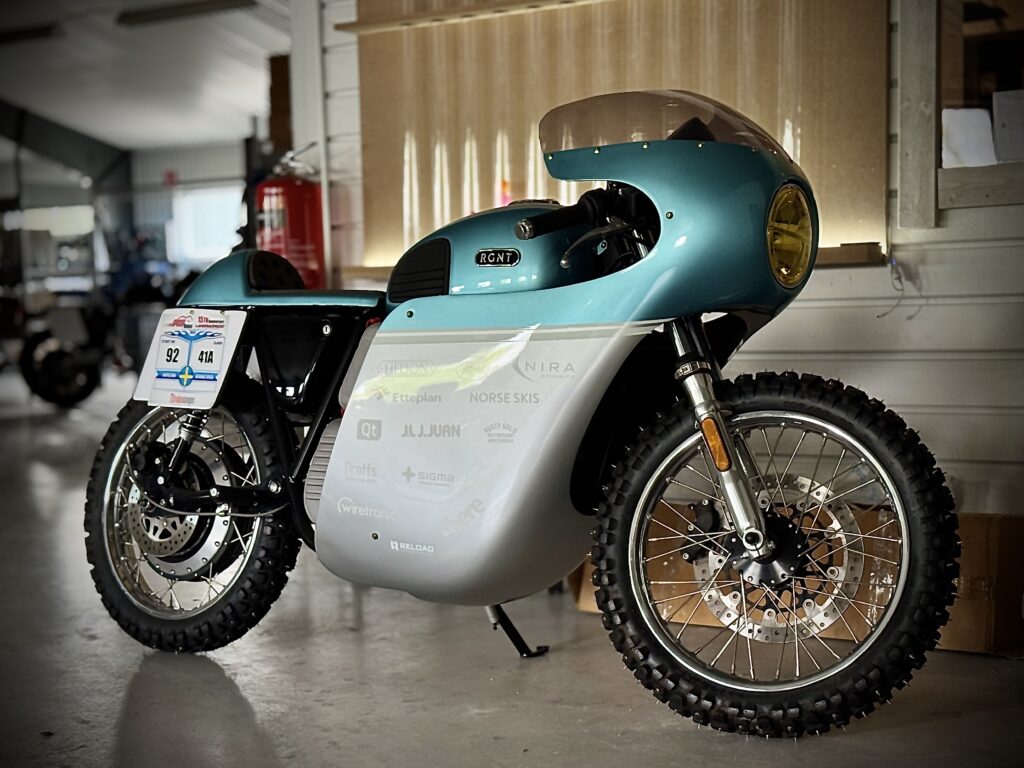
RGNT Motorcycles has now developed eight electric motorcycles, comparable to 300cc bikes, all racing under identical conditions: same tyres, suspension, chassis, and motor. The bikes can be remapped between sessions, but for the Swedish Championship they run with a nominal output of 32 kW in standard mode.
‘And what other mode is there?’ you might ask. RGNT Racing also features a “turbo” mode (also known as push-to-pass). During each race, the rider can activate this turbo boost up to fifteen times, giving an extra output of 52 kW and 520 Nm for ten seconds. The bike weighs 145 kg, with a rear-biased centre of gravity as the hub motor is located in the rear wheel. Goodyear and Dunlop have come on board as tyre sponsors, and all bikes run on Sportmax GPR-300 tyres – regardless of weather. It’s a sporty all-round tyre that doesn’t require tyre warmers, aligning perfectly with the idea of simple and affordable racing.
– “The goal has been to develop an affordable and easy-to-ride single-make class. Think go-karts with your mates – maybe not the world’s best kit, but you’re guaranteed to have loads of fun!” explains Jonathan.
When I visited RGNT this spring to test the RGNT Turbo for road use, half of the race bikes had already been sold. Jonathan notes that interest from female riders was especially high. Anyone who buys an RGNT Racer will also have RGNT as their full-service team at all four Swedish Championship rounds in 2025. The race bikes can be fully charged in one hour, requiring 50 kWh. Power is supplied by a large generator cube transported to each event by RGNT.
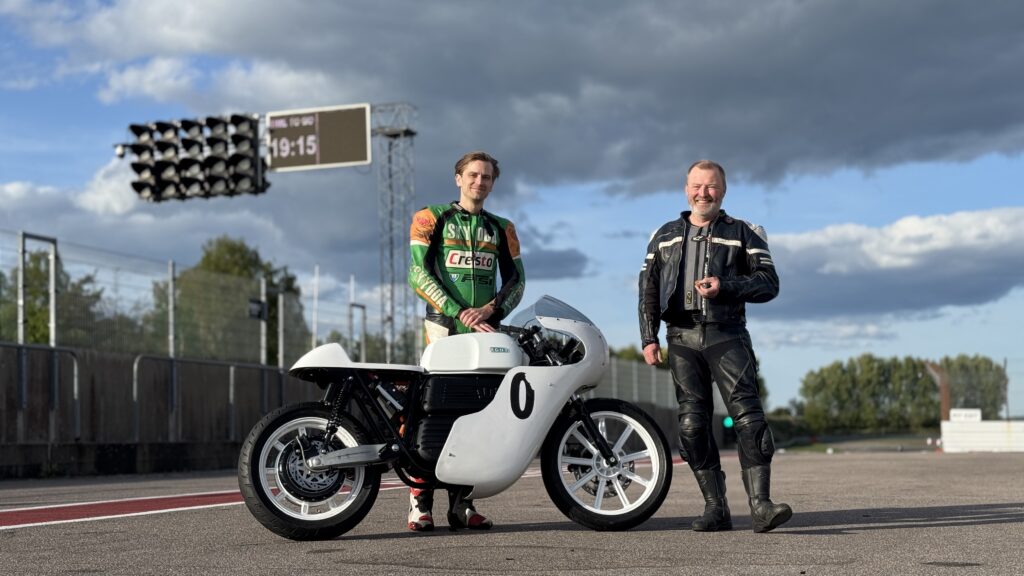
RGNT Racing has a competitive edge over its 300cc-class rivals, both in terms of performance and price. It’s delivered in race-ready condition according to SVEMO regulations, while competitors need modifications (and added costs) to become race-ready.
| Brand / Model | Price (SEK) | Weight (kerb) | Max Output | Power-to-Weight Ratio |
|---|---|---|---|---|
| Kawasaki Ninja ZX-4R | 111,800 | 188 kg | 57.0 kW = 76.5 hp | 0.41 hp/kg |
| Yamaha R3 | 84,900 | 167 kg | 30.9 kW = 41.5 hp | 0.25 hp/kg |
| KTM RC390 | 71,900 | 172 kg | 32.0 kW = 43.5 hp | 0.25 hp/kg |
| RGNT Racing | 65,000 | 145 kg | 32.0 kW (standard) 52.0 kW (boost) | 0.30 hp/kg 0.49 hp/kg |
RGNT Racing comes with a white base paint, allowing riders to customise their own livery. Clip-ons, seat foam, and footpegs are adjusted to suit each buyer. Legally, RGNT cannot sell the bike as road-registered, but accessories for road use are available, and each bike has a VIN number – meaning the owner can register it with the Swedish Transport Agency for street use.
A natural question from a track rider like me: what happens in a crash?
Electric fires and hazardous materials are often concerns with crashed EVs. RGNT has addressed this: the battery is UN-certified and can withstand up to 150G (for reference, astronauts experience 3–5G during a launch). Jonathan explains that only the fairings, footpegs, and grips are likely to be damaged. The battery itself is safely enclosed in a moulded aluminium casing.
Ride Test
First impressions – the bike feels narrow and agile. Seat height is 77 cm, and at 170 cm tall, I can easily put both feet down. Every time the bike is turned off, the turbo boost counter resets, and it’s reactivated by holding the boost button for 10 seconds
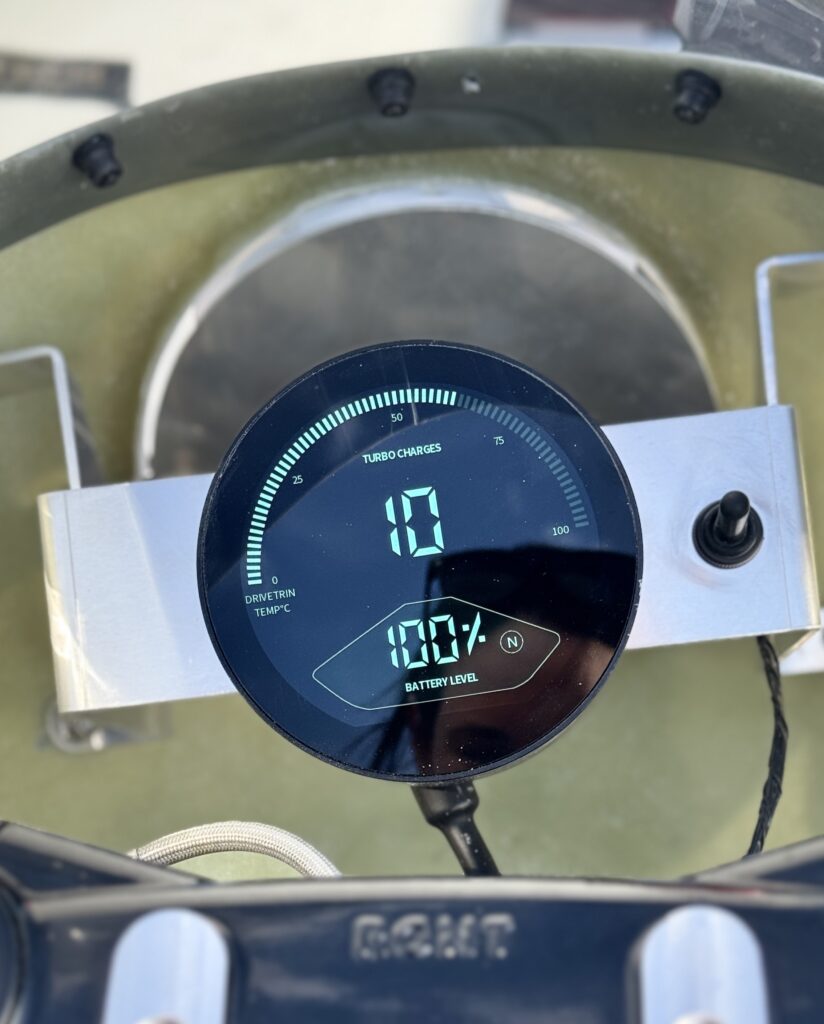
Shifting between ‘neutral’ and ‘drive’ is only indicated by the display – “N” changes to “D” – even if the side stand is down. So be careful not to twist the throttle accidentally, or the bike will move. Riding-wise, the bike is surprisingly forgiving. I dare say almost anyone – age 10 and up – could handle it. There’s no gear lever and no foot-operated rear brake; the clutch lever now controls the rear brake. The footpegs are positioned far back, which makes it hard to anchor yourself, but the bike is still very easy to ride. It rewards a smooth riding style, matching the soft chassis that compensates for the stiffer suspension.
I quickly notice the lack of engine braking. The RGNT Racer keeps rolling where I’d usually roll off the throttle – similar to riding a two-stroke. It just means adjusting your style. I later learn engine braking is adjustable, but in the race version, it’s removed – because regenerative braking produces more heat than discharge.
High-speed corners deliver a surreal sensation – gliding silently. I laugh inside my helmet. Each lap, I hit the turbo earlier out of the final corner, the centre of the display glowing purple while active, and the boost counter ticking down. In boost mode, the power-to-weight ratio reaches 0.5 hp/kg, and yes – the bike does move. It’s a smooth yet powerful surge forward.

The front fairing is wide and tall – some testers noted it can make the bike feel slightly unstable at the end of straights, though not dangerously so. There’s no speedometer, but we know the bike reached a top speed of 192 km/h. The brakes feel a bit underpowered – engine braking would help – but even so, it’s possible to ride fast. Compared to chain-driven petrol bikes, the electric bike is also smoother and less jerky.
One-word summary? Joy.
One test rider highlighted the advantage of the lack of engine noise, summarising the Kinnekulle experience with: “100% I’d buy an RGNT Racing at that price, if it means I can train and race every day.” Another tester was surprised at how fast the bike could go with such basic components – noting tyres and chassis worked together nicely.

Results from the first 2025 Swedish Championship round
The first round took place at Anderstorp’s short 2000-metre circuit (which turns right mid-straight towards the Hansen corner) on Sunday 25 May, with four of the bikes fielded by “friends & family” to ensure functionality. Normally, the ‘RGNT (electric)’ class runs only on Sundays, including practice, qualifying and two races – allowing for lower entry fees.
At Anderstorp, the schedule was slightly different, and it’s fair to say the race officials had their hands full. As many know, spring racing in Sweden is risky – rain and 10°C offers little grip, which was exactly the weather for the first SM Sunday. Multiple crashes occurred, morning practice for RGNT was cancelled, and second races for all classes were scrapped.
Both qualifying and the race were run in the wet. Ola Strandvad qualified on pole by mere hundredths of a second, closely followed by Rickard Carlsson. The race followed a similar pattern – over eight laps, the two leaders swapped positions countless times. In the end, Ola Strandvad claimed victory with a race time of 1:18. Rickard Carlsson came second, with Magnus Sjögren securing bronze.
Riders reported that all previous question marks from testing had now become exclamation marks. All motorcycles performed flawlessly in race conditions, although they tend to run a bit hot when boost is used frequently under heavy loads.
Nobody’s perfect, but thanks to RGNT Motorcycles’ responsiveness to rider feedback, they’ve managed to turn a prototype into a fully functioning race bike in no time. For the second SM round at Sviesta in Linköping on 15 June, all eight bikes are expected to line up. The RGNT (electric) class may be silent, but the excitement speaks for itself. Welcome to a new era!

